In the middle of August while up at the cottage I was looking at reddit.com/r/hockey, as one does. A post caught my eye: Each team’s biggest draft steal since 2010. The graphic displaying the teams and player names looked very nice.
I looked at Ottawa and saw that whoever produced the list had Mark Stone as Ottawa’s draft steal, which is the expected answer if you are a fan of the Senators. While he was a Senator (the golden days) much was made by Ottawa’s broadcasters of how much they had gotten from Stone, who was selected with the 178th pick in the draft. Stone seemed like a reasonable answer, so there was hope for the list.
The hope didn’t last long. Two players on the list have yet to play a minute in the NHL, and others have played a season or two.
In this article, I will explain how drafted players should be evaluated and then will use that process to identify the biggest draft steals by each team.
How Stapled To The Bench (STTB) Evaluates Drafted Players
To evaluate a drafted player, I compare where he was picked to what he has done. A metric is needed that can assign value to both the draft slot and the player’s statistics: I use money.
In The Value of a Draft Pick I explained how a player’s season statistics can be converted to a dollar value: that statistic is called Return From Play (RFP). RFP works for any player in any season, whether he was drafted or signed as a free agent.
As the vast majority of drafted players do not play immediately, a lengthy time frame is needed to determine what sort of player he has become. STTB uses six years, which is about the time frame a team has total control over a player they have drafted.
Also in that article, I explained how each draft slot is converted to a dollar value, which represents a team’s investment in a draftee. I usually refer to this as a team’s cost or their investment, but perhaps a better would be “expectation.” The cost/investment/expectation for a pick is based on the average return of all players drafted between 2007 and 2016, in that part of the draft, over their first six post-draft seasons.
In the 2011 draft, Jonathan Huberdeau was drafted by Florida with the third overall pick. Florida’s investment in Huberdeau was $15,768,000 (the investment figure for picks three through five in the first round). He played with the Saint John Sea Dogs in 2011-12 and started 2012-13 with the Sea Dogs. Midway through the season he broke in with Florida and stayed with Florida for the rest of his first six post-draft seasons. In his four-and-a-half seasons of NHL play, his statistics generated a return of $15,810,000. He produced ever so slightly more than should have been expected in his first six seasons.
A Few More Details
Since a six-seasons-since-drafted time frame is used to evaluate a drafted player, only players drafted between 2007 and 2017 can be evaluated for this article. This eliminates Seattle from consideration and also means that seven other players selected by the Reddit poster will not be considered.
Since the data necessary to calculate RFP goes back to 2007, I will start with the 2007 draftees rather than start at 2010 as the article did. I have no idea why the poster started in 2010. Maybe that is when the poster started watching hockey.
One further limitation is needed for this article: a player must have played NHL games only for his drafting team in his first six post-draft seasons. Looking at Calgary, Adam Fox cannot be considered a steal for them because he never played a game for them. Matthew Tkachuk can be considered a steal, as he was a Flame in his first six post-draft seasons.
Goalies will not be considered. RFP does not work for goalies, and I don’t have an RFStP formula yet (Return From Stopping the Puck).
Profit or Return on Investment?
Mark Stone could be the best player Ottawa has drafted, could be Ottawa’s best draft profit, or could be their biggest draft steal. Let me break things down.
Below you will see a list of the best players drafted from 2007 through 2017. No consideration is given to where in the draft they were selected.
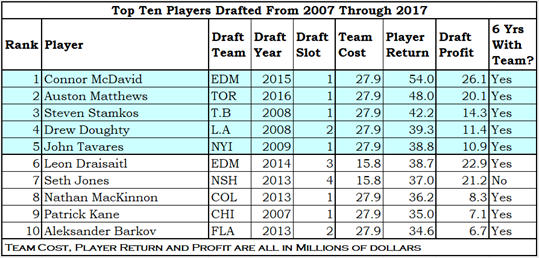
Tangentially, this table shows that the people who draft players know what they are doing. Six of the ten best players were drafted with the first pick, with two-second picks, a third and a fourth finishing the list. With high draft picks, much is expected. These guys are not steals.
In the next table, we will see the top players based on profit, which is determined by subtracting the team’s cost from the player’s return (RFP).
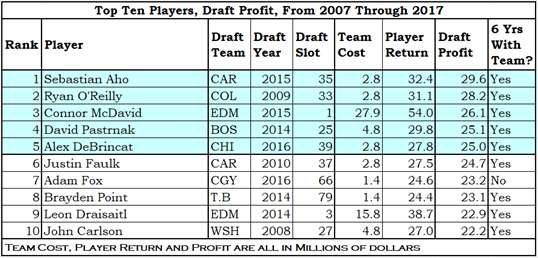
It is amazing that both McDavid and Draisaitl are in this table: much was expected from them, but much more was delivered by them. The table has four first-rounders, four second-rounders, and two third-rounders. We are getting closer to the idea of a draft steal but need to take one more step.
Let’s look at players based on return on investment, which is a player’s RFP divided by the team’s cost. Connor McDavid’s ROI is 93%, meaning he delivered almost twice as much as would be expected by a normal number-one draft pick.
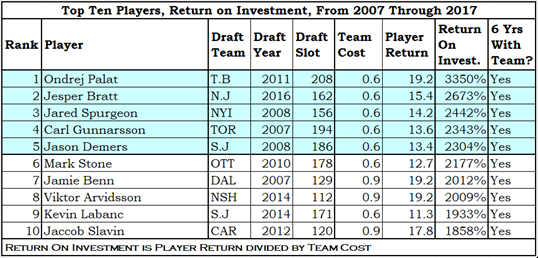
This approach clearly produces a list of the biggest steals ever drafted: players who were selected late in the draft and played extremely well. At number six we see Mark Stone, who we can now say with certainty was Ottawa’s biggest draft steal. The best player Ottawa ever drafted was also the most profitable player they have drafted Erik Karlsson.
This work has set the stage for the table that matters: each team’s biggest draft steal.
Each Team’s Biggest Draft Steal, 2007 to 2017
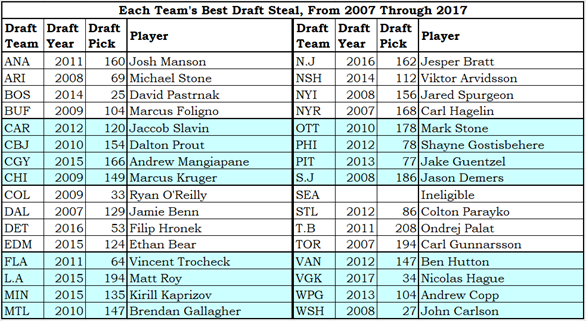
Only six players appear on my list and the redditor’s list. I’ll hazard a guess as to why so few players appear on both lists in the summary.
Summary
I assume the article on Reddit was based strictly on a person’s opinions. How else can two teams have their biggest draft steals be somebody who has yet to play in the NHL? How else can the list have nine first-round picks and only two late-round picks identified as steals?
How can the list have players who didn’t have a good season in their first six seasons, such as MacKenzie Weegar (FLA)? None of his great seasons were in his first six post-draft seasons. Consider his Career Productivity Rating chart:
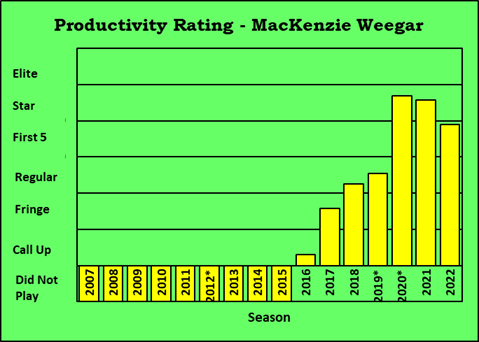
2020-21 was obviously his breakout season, his fifth season in the NHL. The problem is that Weegar was drafted in 2013 and he was evaluated on his first six post-draft seasons (2013 through 2018), not his first six NHL seasons (2016 through 2021).
I do not want to be seen as criticizing the Redditor. He (assuming the poster was male) is entitled to his opinion and can use whatever methodology he desires.
I, too, am entitled to my opinion and my methodology. I chose to use a mathematical approach when answering hockey questions. I choose to evaluate all players with one process. My opinion is that my process will identify players fairly and accurately.
For this article, I asked the data who the best draft steals were, and the data and I had a conversation where we confirmed what “steal” means, and then the data provided the answer. Every player who was drafted was evaluated, so it wasn’t possible for me to overlook players I didn’t remember (like Josh Manson, ANA).
I will concede that my table is not as nice looking as the Redditor’s table.
Related Articles
